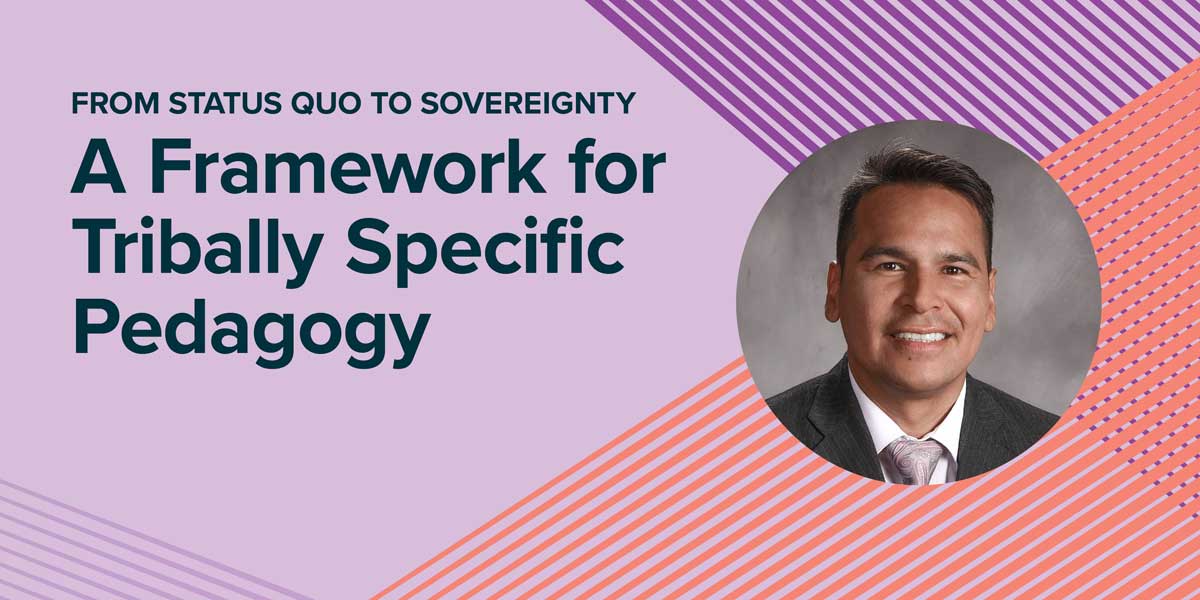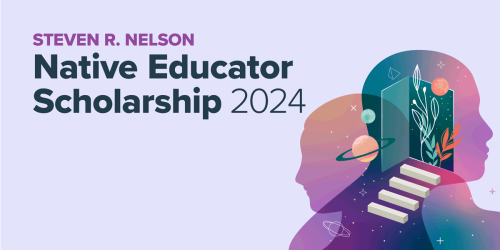From Status Quo to Sovereignty: A Framework for Tribally Specific Pedagogy

To serve Indigenous students well, we need to rethink how we teach. We need to move away from the status quo and toward educational sovereignty. That means giving Tribes control over their children’s education and delivering education that aligns with their cultural practices and values.
On behalf of our Native education team at Education Northwest, I am excited to introduce a new framework to support Tribes in reclaiming educational sovereignty—and bringing local education systems along with them.
Below, before I explain the framework, I share how my experiences as an Indigenous educator supporting Indigenous students led me to develop this tool.
Lessons From Supporting Native Students in STEM
For years, I was curious why students of color—especially Indigenous students—were not seeking careers in STEM.
As a college student, I returned to the Native-serving math and science camps I had attended as a teen—this time as a counselor. I noticed that many students struggled in one main area: math. Math was a gatekeeper content area that prevented them from advancing in STEM.
I knew there must be a systemic barrier at work. Indigenous cultures and traditions are rich in math and science after millennia of thriving as problem-solving communities— since before colonization. As just one example, my Anishinaabe ancestors used complex geometry to build our traditional dwelling structures.
If teachers could tap into the inherent problem solving and high order thinking skills that already exist in Indigenous culture, I knew they could make math more engaging and relevant for Indigenous students.
Eventually I became a teacher, then an instructional coach. For two decades, I helped teachers provide real-world, culturally responsive learning experiences, especially in STEM. I did this by putting content into cultural context, such as in this high school geometry lesson on wigwams.
Teaching Culturally Across Content Areas
One day I realized that if we can figure out better ways to teach math, then there must also be better ways to teach to specific groups of students across content areas. If we changed how we taught, we could create the conditions for Indigenous students to succeed.
If we changed how we taught, we could create the conditions for Indigenous students to succeed.
It dawned on me that teaching culturally is key. My geometry lesson on wigwams wasn’t only successful because it taught what wigwams are or why they are used. The lesson was successful because it taught critical math concepts using practices that reflect the values of local Indigenous students, like hands-on engagement and place-based learning.
The beauty of teaching culturally is that it is accessible to any teacher, regardless of their content area or cultural background. To teach Indigenous students culturally, educators don’t need to teach Indigenous culture, they simply need to become more invested in the how to teach—what instructional methods to use in their content area that incorporate and reflect their students’ cultural values.
Introducing the Framework for Tribally Specific Pedagogy
Enter the Framework for Tribally Specific Pedagogy, a tool to help educators, leaders, advocates, and communities chart a path forward to teach Indigenous students in a way that is culturally appropriate and specific to their unique context, Tribal understandings, and landscape. The framework aims to help Tribes articulate and share a pedagogy grounded in their specific values and cultural understandings. The process involves four key steps, beginning with family and community engagement and measuring effectiveness.
Remembering Pedagogy Through Community
The first step for Tribes is to engage their community in locating, naming, and centering the traditional ways of teaching and learning that are appropriate and will be valuable to educators. Tribes must lean on their citizens or community members in this process: You can't ask somebody who is not from the community to come in and define it as an outsider. The only way to ensure the pedagogy is comprehensive and vetted is to give everybody from the community a say.
This process of engagement can be especially empowering for Indigenous parents and caregivers. Most of these important community members don’t feel like they have a say in schools, or they feel like education needs to be left to experts. For centuries, the education system was intentionally used by the U.S. government to deconstruct and disqualify Indigenous identity. It’s empowering when we engage and hold up the inherent knowledge of families and caregivers in the process and say, “What do you think is effective in a classroom for your child?” You're giving them a say in how the space where their children learn feels and functions, which can be very motivating.
Connecting Traditional Knowledge to Evidence-Based Practice
Once Tribes articulate their pedagogy, we can begin to tie in evidence-based instructional practices, most of which are not strange or new to the pre-colonial learning systems of Tribal groups around the country. In this stage, our Native education team draws from our expertise to identify practices that reflect back that pedagogy of the Tribe. For example, in many Indigenous cultures, errors are considered an expected part of the learning process, while in mainstream education students are taught to avoid them, an idea that is reinforced by standardized testing. An Indigenous pedagogy, therefore, might call for teachers to use non-examples or counterexamples to reinforce a learning topic.
In many cases, we see strong alignment between Indigenous and evidence-based practice. As Tribes start to uncover their own values and the way they used to teach and learn, it’s easy to link things and say, “Oh, that's like growth mindset!” or “That's like multi-tiered systems of support!”
For example, storytelling is a common practice across many Indigenous cultures. When you learn information, you learn it in a story. The information is contextualized. You're not just learning something abstract; you're learning the why. Why animals behave a certain way. Why certain land formations exist around you. Why certain trees have certain bark patterns. As educational practitioners, we can map this traditional practice of storytelling onto the evidence-based practice of contextualization.
Another example of a common Indigenous cultural value is personal sovereignty. This is the idea that if you feel responsibility toward what you’re learning—if you’re deciding what you want to learn—then you have a greater ability to learn and comprehend that topic. We can map this onto the evidence-based practice of student choice.
There’s a lot of catching up that Western education … can do to align with the best practices that already exist in Indigenous cultures
As an Indigenous person, it’s reaffirming to see Indigenous pedagogy being supported, however slowly, by Western and mainstream research. There’s a lot of catching up that Western education, which has largely been shaped by an industrial and individualistic mindset, can do to align with the best practices that already exist in Indigenous cultures—and this framework can help that process.
Equipping Educators with Culturally Validating and Sustaining Teaching Methods
The Framework for Tribally Specific Pedagogy is deeply informed by work I have conducted directly with Tribes over the past decade. For example, in 2014 I started working with the Nez Perce Tribe in Idaho to implement a Tribal pedagogy process—work that is still ongoing. The Tribe’s education department surveyed more than 100 of its citizens about learning experiences outside the classroom, then summarized and categorized the responses into nine distinct instructional strands. These strands eventually became the Nez Perce Indigenous Principles of Pedagogy, after review cycles with Tribal families, elders, educators, and school leaders.
Once the Tribe articulated a pedagogy, they began to offer professional development for educators through the local college: an introductory course to the foundations and principles of Indigenous pedagogy and a second course on integrating Indigenous pedagogy into classroom instruction.
Our framework can also help administrators support their classroom teachers in implementing the pedagogy. For example, elements of the Danielson Framework for Teaching may reflect a Tribally specific pedagogy. Once we identify which practices align with the pedagogy, we can coach administrators to use observation tools that will help them identify those practices in the classroom.
Creating Metrics and Measuring Effectiveness
Finally, the framework can be used to create metrics for the effectiveness of selected practices. We work with Tribes to design levels of implementation that reflect levels of mastery of Indigenous pedagogy. These levels can be “emerging” to “expert” and based on visual evidence of the practice that can be observed in the classroom. Together, we also develop metrics to gauge student responsiveness to the strategies.
The Broader Movement for Educational Sovereignty
Our framework is just one way that Tribes and Indigenous communities are reclaiming educational sovereignty. In recent years, our team has been honored to support many related projects. We have partnered with Tribes and school districts to create and implement Tribal curriculum, conducted Indigenous community needs assessments with state education agencies, and trained Tribal college staff members on best practices in data or assisted with strategic planning. Across this work, we continue finding new ways to infuse traditional knowledge and an awareness of the Tribal and community assets that should better help inform our education systems.
Fittingly, educational sovereignty is the theme of the 2024 National Indian Education Association Convention, taking place this October. My colleague Mandy Smoker Broaddus and I will be on site to present our new framework and learn from our colleagues across the field. If you plan to attend, I hope you will join our session to learn more about our framework and to share your ideas and questions.
RunningHorse Livingston has collaborated with Tribes and rural communities in more than 30 states. He specializes in providing culturally responsive technical assistance, professional development, curricular development, and instructional coaching, particularly in math and science. He is a proud citizen of the Bad River Band of Lake Superior Chippewa and is based in Madison, Wisconsin.



